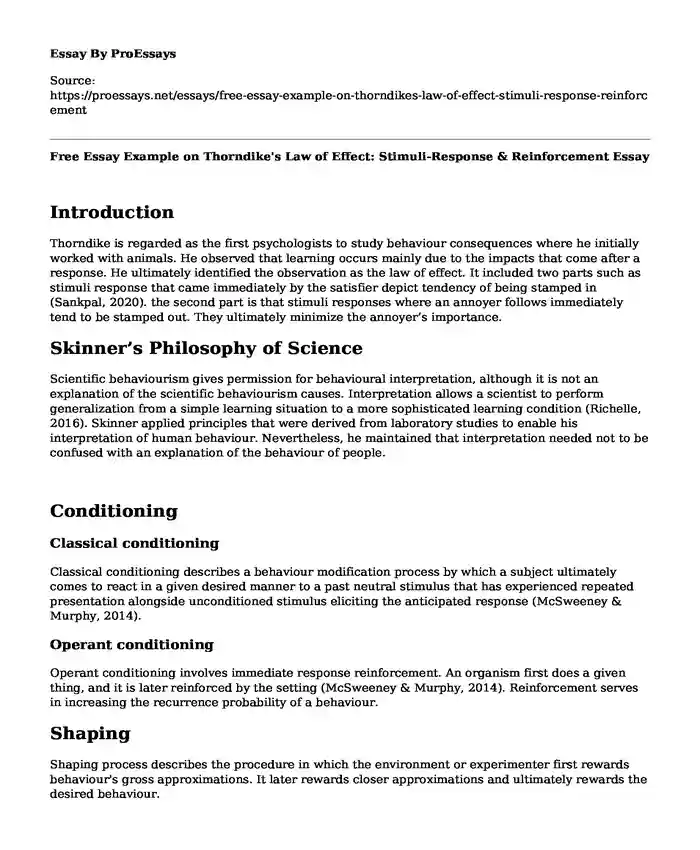Introduction
Thorndike is regarded as the first psychologists to study behaviour consequences where he initially worked with animals. He observed that learning occurs mainly due to the impacts that come after a response. He ultimately identified the observation as the law of effect. It included two parts such as stimuli response that came immediately by the satisfier depict tendency of being stamped in (Sankpal, 2020). the second part is that stimuli responses where an annoyer follows immediately tend to be stamped out. They ultimately minimize the annoyer’s importance.
Skinner’s Philosophy of Science
Scientific behaviourism gives permission for behavioural interpretation, although it is not an explanation of the scientific behaviourism causes. Interpretation allows a scientist to perform generalization from a simple learning situation to a more sophisticated learning condition (Richelle, 2016). Skinner applied principles that were derived from laboratory studies to enable his interpretation of human behaviour. Nevertheless, he maintained that interpretation needed not to be confused with an explanation of the behaviour of people.
Conditioning
Classical conditioning
Classical conditioning describes a behaviour modification process by which a subject ultimately comes to react in a given desired manner to a past neutral stimulus that has experienced repeated presentation alongside unconditioned stimulus eliciting the anticipated response (McSweeney & Murphy, 2014).
Operant conditioning
Operant conditioning involves immediate response reinforcement. An organism first does a given thing, and it is later reinforced by the setting (McSweeney & Murphy, 2014). Reinforcement serves in increasing the recurrence probability of a behaviour.
Shaping
Shaping process describes the procedure in which the environment or experimenter first rewards behaviour's gross approximations. It later rewards closer approximations and ultimately rewards the desired behaviour.
Reinforcement potentially observes behaviour on either an intermittent schedule or a continuous schedule. The four schedules of reinforcement include variable-ratio, fixed ratio, variable interval and fixed interval.
Reinforcers
Conditioned reinforcer
It is also known as a secondary reinforcer. Stimuli of the environment that are not perceived by nature as satisfying, although become so due to their association with the primary or unlearned reinforcers (Russell et al., 2018). They include water, food or physical comfort.
Generalized reinforcers
They are kinked to over one reinforcer. They include approval, attention, submission of other people, affection and money or tokens (Russell et al., 2018).
Methods of Social Control and Self-Control
The social control methods, according to Skinner, include describing contingencies, operant conditioning, physical restraint and deprivation and satiation.
Operant conditioning includes both negative and positive reinforcement and punishment. Society depicts control entirely over the members of society. Describing contingencies or the use of language to inform individuals of the behaviours' repercussions. It serves to inform individuals of repercussions of the behaviour that is yet to be emitted. The next method is deprivation and satiation that describes methods that increase the possibility that individuals will depict a particular behaviour. Finally, physical restraint method includes the jailing of criminals. It also involves holding a child back from the ravine and fails to negate freedom.
Skinner’s Approach
Counteracting strategies
Methods of self-control and social control are regarded that sometimes they possibly lead to detrimental impacts. If social control becomes excessive, individuals potentially utilize three primary strategies for counteracting. First, people consider escaping from social control, which involves withdrawing from controlling agent psychologically or physically. The next technique includes revolting from social control, such as the vandalism of public property. The third strategy is passively resisting the social control more subtle such as stubbornness.
Inappropriate behaviour
It is shaped by both positive and negative reinforcement of punishment. Counteraction of social control of unsuccessful self-control attempts. It involves techniques such as excessively restrained behaviour, vigorous behaviour and blocking reality through merely avoiding paying attention to any aversive stimuli. Undesirable behaviours usually emerge due to defective self-knowledge.
Conclusion
Watson took radical determinism, behavioralism, and environmental forces beyond the conception of Skinner by ignoring generic elements entirely and offering to shape personality through the control of the environment. He studied both humans and animals, and he was persuaded that both introspection and consciousness concepts ought to play no role in the scientific study of human conduct (Sankpal, 2020). The conduct of humans can require an objective study. Watson attacked introspection and consciousness notions. Besides, he attacked notions of sensation, instinct, motivation, perception, mental states, imagery and mind.
References
McSweeney, F. K., & Murphy, E. S. (2014). The Wiley Blackwell handbook of operant and classical conditioning. John Wiley & Sons.
Ramirez, K. (2020). Choosing the Right Method: Reinforcement vs Punishment. Zoo Animal Learning and Training, 53-67. https://doi.org/10.1002/9781118968543.ch4Richelle, M. N. (2016). BF Skinner. Psychology Press.
Russell, D., Ingvarsson, E. T., Haggar, J. L., & Jessel, J. (2018). Using progressive ratio schedules to evaluate tokens as generalized conditioned reinforcers. Journal of applied behaviour analysis, 51(1), 40-52. https://doi.org/10.1002/jaba.424
Sankpal, S. (2020). Theories of Learning and Their Educational Implications.
Cite this page
Free Essay Example on Thorndike's Law of Effect: Stimuli-Response & Reinforcement. (2023, Oct 10). Retrieved from https://proessays.net/essays/free-essay-example-on-thorndikes-law-of-effect-stimuli-response-reinforcement
If you are the original author of this essay and no longer wish to have it published on the ProEssays website, please click below to request its removal:
- Motorcycle Man
- Psychology Paper Sample: How Parental Verbal Abuse Affects Child Personality and Social Behavior
- We Need Love to Lead a Meaningful Life Speech
- Research Paper on Effects of Aging and Mitral Valve Prolapse
- Essay on Old Age Disorders: A Study of Dementia and Beyond
- Paper Example on Learning Styles in Student Evaluation
- Stress: Mental Health and Physical Health Linked - Essay Sample







